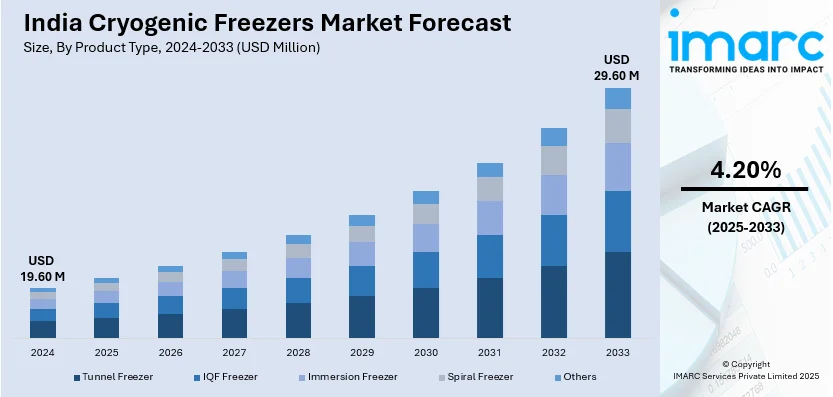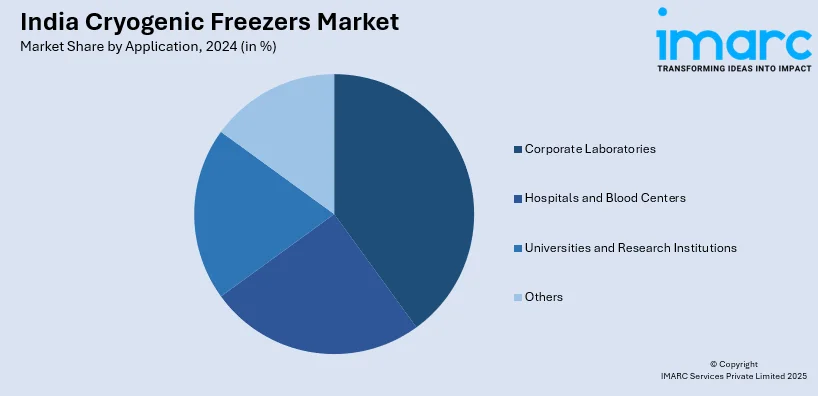
India Cryogenic Freezers Market Size, Share, Trends and Forecast by Product Type, Application, End Use Industry, and Region, 2025-2033
India Cryogenic Freezers Market Overview:
The India cryogenic freezers market size reached USD 19.60 Million in 2024. Looking forward, IMARC Group expects the market to reach USD 29.60 Million by 2033, exhibiting a growth rate (CAGR) of 4.20% during 2025-2033. The increasing biomedical research, expanding biobanking applications, rising demand for vaccine storage, advancements in cryopreservation technologies, government support for healthcare infrastructure, and the growing pharmaceutical sector are some of the major factors positively impacting the India cryogenic freezers market share.
|
Report Attribute
|
Key Statistics
|
|---|---|
|
Base Year
|
2024 |
|
Forecast Years
|
2025-2033
|
|
Historical Years
|
2019-2024
|
| Market Size in 2024 | USD 19.60 Million |
| Market Forecast in 2033 | USD 29.60 Million |
| Market Growth Rate (2025-2033) | 4.20% |
India Cryogenic Freezers Market Trends:
Expansion of Vaccine and Biopharmaceutical Cold Storage Infrastructure
The Indian government and private sector players are investing in advanced cold storage solutions, including cryogenic freezers, to support vaccine development, biologic drugs, and biosimilars, which is positively influencing the India cryogenic market outlook. The COVID-19 pandemic accelerated this trend, with increased demand for ultra-low temperature freezers to store mRNA vaccines. Companies such as Godrej Appliances and Blue Star Limited are significantly expanding their cold chain offerings, integrating cryogenic storage into pharmaceutical supply chains. The rise in biosimilar production, driven by India's strong position in generic pharmaceuticals, is pushing biopharma companies to enhance cold storage infrastructure for monoclonal antibodies, recombinant proteins, and gene therapies. In addition to this, regulatory agencies, including the Central Drugs Standard Control Organization (CDSCO), are enforcing stringent storage requirements for biologics, leading to the adoption of high-performance cryogenic freezers. According to the India Brand Equity Foundation report, there are 36 significant vaccine production facilities in India, and India is a major provider to more than 150 nations. This ongoing expansion of vaccine manufacturing facilities, especially for export markets, is reinforcing the need for reliable ultra-low temperature storage solutions.

To get more information on this market, Request Sample
Increasing Adoption of Cryopreservation in Biobanking and Regenerative Medicine
India's biobanking sector is expanding as healthcare institutions, research centers, and pharmaceutical companies prioritize long-term biological sample preservation. Cryogenic freezers are critical for storing cells, tissues, blood, and genetic material under ultra-low temperatures to maintain viability. The demand is rising due to the growth of stem cell research, personalized medicine, and regenerative therapies. Stem cell banking is witnessing increasing investment, with companies such as LifeCell International and Cordlife Sciences India expanding cryogenic storage capacities. Furthermore, the implementation of government initiatives supporting biomedical research and funding programs for genetic studies further contribute to this trend. For instance, on March 8, 2025, the Indian Council of Medical Research (ICMR) introduced the Medical Innovations Patent Mitra initiative to strengthen India's healthcare innovation and patent ecosystem. This program offers comprehensive support for patent filings and technology transfers, aiming to enhance the impact of biomedical research and promote a self-reliant healthcare sector. Additionally, advancements in cryogenic freezer technology, such as improved insulation, automated monitoring, and temperature stability, are ensuring higher sample integrity, which is providing an impetus to India cryogenic freezer market growth.
India Cryogenic Freezers Market Segmentation:
IMARC Group provides an analysis of the key trends in each segment of the market, along with forecasts at the country level for 2025-2033. Our report has categorized the market based on product type, application, and end use industry.
Product Type Insights:
- Tunnel Freezer
- IQF Freezer
- Immersion Freezer
- Spiral Freezer
- Others
The report has provided a detailed breakup and analysis of the market based on the product type. This includes tunnel freezer, IQF freezer, immersion freezer, spiral freezer, and others.
Application Insights:

- Corporate Laboratories
- Hospitals and Blood Centers
- Universities and Research Institutions
- Others
A detailed breakup and analysis of the market based on the enterprise size have also been provided in the report. This includes corporate laboratories, hospitals and blood centers, universities and research institutions, and others.
End Use Industry Insights:
- Food and Beverages
- Medical and Healthcare
- Pharmaceuticals
- Chemicals
- Others
The report has provided a detailed breakup and analysis of the market based on the end use industry. This includes food and beverages, medical and healthcare, pharmaceuticals, chemicals, and others.
Regional Insights:
- North India
- South India
- East India
- West India
The report has also provided a comprehensive analysis of all the major regional markets, which include North India, South India, East India, and West India.
Competitive Landscape
The market research report has also provided a comprehensive analysis of the competitive landscape. Competitive analysis such as market structure, key player positioning, top winning strategies, competitive dashboard, and company evaluation quadrant has been covered in the report. Also, detailed profiles of all major companies have been provided.
India Cryogenic Freezers Market News
- On September 11, 2024, Inox India Limited, which was established in 1976, specializes in designing, engineering, manufacturing, and installing equipment and systems for cryogenic conditions. The company announced it had secured patent rights from the Government of India's Patents Office for its "Cryogenic Liquid Base Variable Temperature Cold Storage Unit and Method."
- On September 17, 2024, OctoFrost announced that a prominent Indian food processor selected its individual quick freezing (IQF) technology to freeze products such as corn kernels, baby corn, and mangoes. The decision was influenced by OctoFrost's advanced technology and strong industry reputation, further supported by positive references from existing clients. This development signifies OctoFrost's expanding presence in the Indian market.
India Cryogenic Freezers Market Report Coverage:
| Report Features | Details |
|---|---|
| Base Year of the Analysis | 2024 |
| Historical Period | 2019-2024 |
| Forecast Period | 2025-2033 |
| Units | Million USD |
| Scope of the Report |
Exploration of Historical Trends and Market Outlook, Industry Catalysts and Challenges, Segment-Wise Historical and Future Market Assessment:
|
| Product Types Covered | Tunnel Freezer, IQF Freezer, Immersion Freezer, Spiral Freezer, Others |
| Applications Covered | Corporate Laboratories, Hospitals, Blood Centers, Universities, Research Institutions, Others |
| End Use Industries Covered | Food, Beverages, Medical, Healthcare, Pharmaceuticals, Chemicals, Others |
| Regions Covered | North India, South India, East India, West India |
| Customization Scope | 10% Free Customization |
| Post-Sale Analyst Support | 10-12 Weeks |
| Delivery Format | PDF and Excel through Email (We can also provide the editable version of the report in PPT/Word format on special request) |
Key Questions Answered in This Report:
- How has the India cryogenic freezers market performed so far and how will it perform in the coming years?
- What is the breakup of the India cryogenic freezers market on the basis of product type?
- What is the breakup of the India cryogenic freezers market on the basis of application?
- What is the breakup of the India cryogenic freezers market on the basis of end use industry?
- What is the breakup of the India cryogenic freezers market on the basis of region?
- What are the various stages in the value chain of the India cryogenic freezers market?
- What are the key driving factors and challenges in the India cryogenic freezers market?
- What is the structure of the India cryogenic freezers market and who are the key players?
- What is the degree of competition in the India cryogenic freezers market?
Key Benefits for Stakeholders:
- IMARC’s industry report offers a comprehensive quantitative analysis of various market segments, historical and current market trends, market forecasts, and dynamics of the India cryogenic freezers market from 2019-2033.
- The research report provides the latest information on the market drivers, challenges, and opportunities in the India cryogenic freezers market.
- Porter's five forces analysis assist stakeholders in assessing the impact of new entrants, competitive rivalry, supplier power, buyer power, and the threat of substitution. It helps stakeholders to analyze the level of competition within the India cryogenic freezers industry and its attractiveness.
- Competitive landscape allows stakeholders to understand their competitive environment and provides an insight into the current positions of key players in the market.
Need more help?
- Speak to our experienced analysts for insights on the current market scenarios.
- Include additional segments and countries to customize the report as per your requirement.
- Gain an unparalleled competitive advantage in your domain by understanding how to utilize the report and positively impacting your operations and revenue.
- For further assistance, please connect with our analysts.
 Request Customization
Request Customization
 Speak to an Analyst
Speak to an Analyst
 Request Brochure
Request Brochure
 Inquire Before Buying
Inquire Before Buying




.webp)




.webp)












